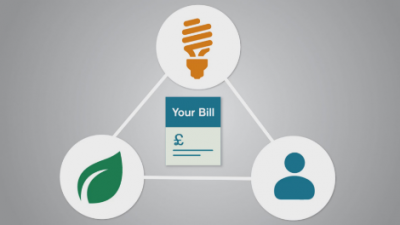- Rachel Fletcher
- Publication date
- Industry sector
- Supply and Retail Market
As we head into winter when people tend to spend more on heating and lighting their home, it’s natural that interest in energy prices picks up. Ofgem does not set the prices you pay for your gas and electricity but we are working to help everyone get a good deal. We also provide information about trends in the different costs that make up your energy bill.
There are many factors that suppliers take into account when setting energy prices. These include the wholesale cost of the energy they buy on their customers’ behalf, the costs for using and upgrading the pipes and wires which transport energy and the costs of delivering the government’s environmental and social programmes. Reductions in one area may be offset by rises in other areas.
To provide a fuller picture of how all these different elements interact and to understand trends in suppliers’ costs, we will soon be launching a new indicator on our website which we will update regularly. In the meantime, this blog will explain some of the current trends affecting energy prices and what you can do to get a better deal in light of the costs that suppliers are currently facing.
The role of competition
Suppliers’ costs differ depending on things like how they buy electricity and gas on the wholesale market and their overheads, such as IT systems. There are more suppliers than ever before competing for your business and more people switching supplier to get a better deal. In a competitive market, suppliers are under pressure to keep their costs, and hence their prices, down to win new customers and keep their existing ones.
This, together with falls in wholesale prices in 2014 and 2015, contributed to the significant fall in the prices of fixed-term tariffs in the last two years. However, as the Competition and Markets Authority confirmed when it concluded its market investigation this summer, competition is not working effectively for the two thirds of customers who remain on standard variable tariffs. As a result, these people are paying substantially more - currently around £300 for a typical customer - for the energy that they use compared to those who switch to the cheapest deals.
Wholesale costs
Wholesale energy costs make up nearly half an average household energy bill. Wholesale prices are volatile but the overall trend in 2016 so far has been upwards. Wholesale prices for delivery in winter 2016 were about 20% higher in September compared to the start of the year. In recent months, a number of suppliers have increased their prices of the fixed-term tariffs that they offer.
Despite this, wholesale prices are still lower compared with the last few years after falling in 2014 and 2015. Many of the larger suppliers purchase energy for customers on their standard variable tariffs significantly in advance of delivery, and so, for these suppliers, changes in wholesale prices feed through into costs only gradually.
Network and balancing costs
Network charges cover the cost of transporting electricity and gas to consumers. Balancing charges, which include the costs National Grid incurs to balance the electricity system, also end up on your bill but are relatively small. Together, these costs make up around a quarter of an average household bill.
Network costs are added onto the price of each unit of electricity and gas which is consumed. Total network costs do not vary by much year on year. However because overall consumption has fallen, the network charge per unit of energy consumed which ends up on your energy bill has risen this year.
Government obligations
These costs relate mainly to government obligations on suppliers to deliver environmental and social programmes and account for around 7% of an average household bill. They have risen in 2016, as a result of higher charges to help support renewable and low-carbon electricity generators, and we expect these charges to rise further in 2017. There is also likely to be a redistribution of charges to suppliers for environmental levies, which will see households and many businesses pay a higher proportion of these, while energy-intensive industrial customers will see reductions in their bill. There will also be upwards pressure on costs as suppliers start making capacity payments designed to help secure the country’s energy supplies.
Although these increases may be partly offset by a reduction in the costs associated with delivering energy efficiency measures under the ECO scheme, overall we expect suppliers’ costs associated with government obligations to increase significantly over the coming year.
VIDEO GUIDE IN FULL: Your energy bills explained >
How to get the best deal this winter
Following the CMA’s investigation, Ofgem is working to make the market more competitive and put pressure on suppliers to keep their costs - and prices – down for all consumers, including those on standard variable tariffs. We will also protect those on pre-payment meters, who include some of the most vulnerable consumers and those least able to benefit from competition, by capping prices from April next year.
In the meantime, you can benefit from cheaper prices by shopping around for a good deal. If you’re on your supplier’s standard variable tariff, it's very likely you're getting a poor deal.
Another factor determining the size of your bill is how much energy you use. Investing in energy efficiency measures such as loft insulation can help reduce your bill.
